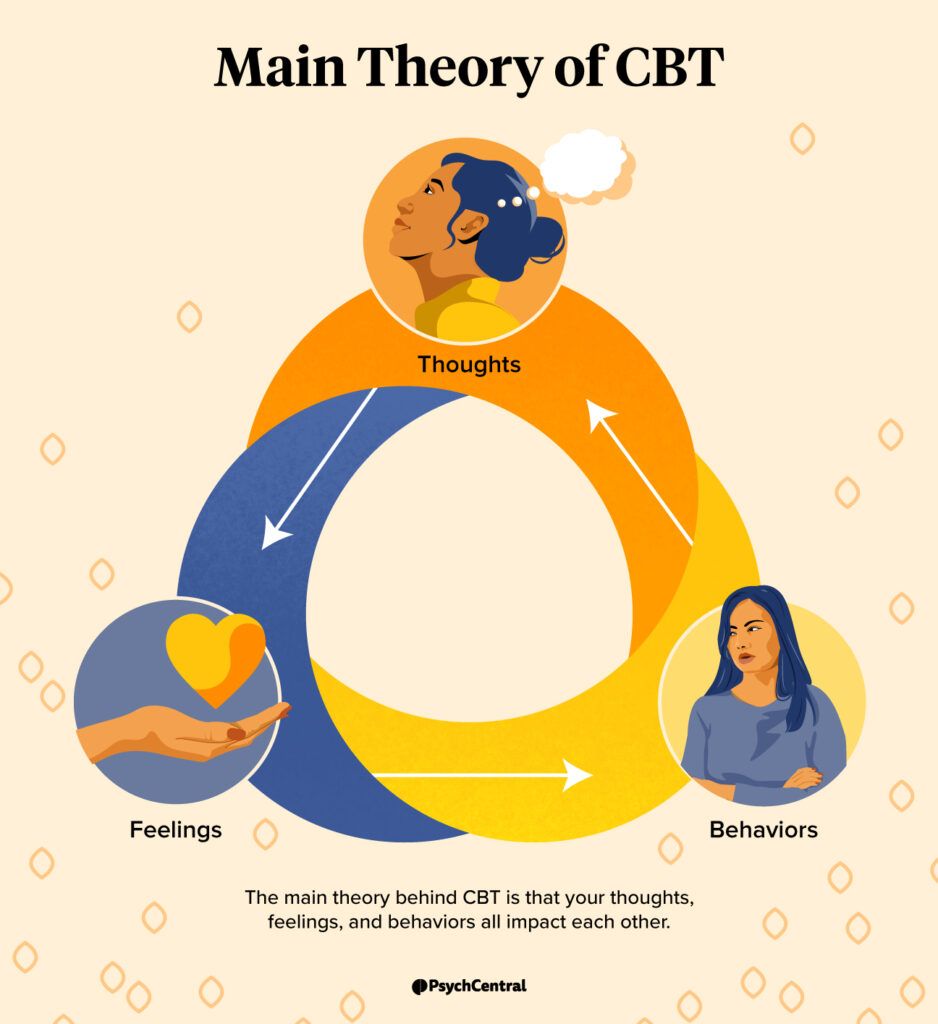The main theory behind CBT is that your thoughts, feelings, and behavior all impact each other.
Using specific cognitive behavioral therapy (CBT) techniques, you can replace problematic thought patterns with more positive or helpful ones. This type of therapy can help you reframe your perspective and view life’s challenges in a new way.
Many therapists use CBT principles to help clients develop coping skills and better manage stressful situations.

CBT can help people identify and deconstruct difficult or harmful thought patterns. This can lead to positive outcomes for their emotions and behavior. CBT is a goal-oriented, time-based, structured treatment.
This psychological treatment can help with a wide range of mental health issues, including:
- anxious thoughts
- anxiety disorders
- depression
- substance misuse or substance use disorder
- eating disorders
“[CBT is] rooted in the idea that thoughts impact feelings and feelings impact behavior,” says Sarah Kaufman, LMSW. “Therefore, if we can reframe our thoughts, we can subsequently change our feelings and then our behavior.”
Reframing your thoughts can help alleviate anxiety and improve your quality of life.
Easton Gaines, PsyD, a licensed psychologist, explains that there are three levels of cognition in CBT:
1. Core beliefs
Our core beliefs are informed by our childhood experiences. They are deeply rooted in how we view ourselves, our environment, and the future, along with our beliefs about these factors.
2. Dysfunctional assumptions
Humans tend to hold onto the negative more easily than the positive. However, these cognitive distortions are irrational thought patterns that distort our perceptions of reality.
3. Automatic negative thoughts
Automatic negative thoughts are involuntary negative perceptions of reality that occur out of habit. They can be difficult to recognize since they are brief and cause negative emotions.
“If you can change how you think about a situation or how you respond to a situation, then you can change how you feel in a situation,” Kristel Roper, LMFT, LPCC, explains. “This can be a powerful tool, as it’s difficult (if not impossible) to just turn your feelings on or off.”
It’s also important to understand that we all have distorted thoughts at times. These are known as cognitive distortions. Examples of cognitive distortions include:
- all-or-nothing thinking, such as thinking that you’re a failure for making one mistake
- “should” statements, or believing that you should never make mistakes
- overgeneralization, which is the belief that you’ll always get it wrong or that things will never get better
It’s important to understand that we do not have to believe our thoughts. We have a choice in how we respond to our thoughts, and, with practice, we can learn to challenge these thoughts and respond in kinder, more realistic, and more helpful ways, Roper adds.
Example: Reframing automatic negative thoughts
Scenario 1. Someone passes you in the hallway and does not say hello. You think: They don’t like me. “In this scenario, you might feel sad or disappointed, and then as a result, perhaps you avoid that person at work or frequently think about what you might do to get them to like you,” Kaufman explains.
Scenario 2. Someone passes you in the hallway and does not say hello. You think: They must be busy today. “This may cause you to feel neutral or unfazed, and then as a result, you don’t give it another thought and move on with your day,” says Kaufman. “Or, perhaps you feel compassion toward the person and offer to help them with their work.”
Though each CBT session is different, here are some popular CBT techniques that many therapists use.
Decatastrophizing
Catastrophic thinking, or catastrophizing, is a common cognitive distortion where you automatically believe the worst possible outcome will happen, no matter how unlikely it is.
A decatastrophizing exercise can be helpful if you find yourself worrying about something specific over and over again.
When you find yourself caught in catastrophic thinking, Kaufman recommends asking yourself the following questions:
- What am I worried about?
- How likely is it that my worry will come true?
- If my worry comes true, what’s the worst that could happen?
- If my worry comes true, what’s most likely to happen?
- If my worry comes true, what are the chances I’ll be okay?
The ABC technique
When using this technique, you consider the activating event (A), your behaviors (B), and the consequences (C). For instance:
- Bobby said something mean to me (A)
- I responded by kicking him (B)
- I got into trouble at school (C)
“The ABC technique looks at what happened, how you acted, and what happened next,” Jessica Biren Caverly, PhD, a licensed psychologist, explains. “We often use this same theory for criminals. What caused you to steal (A), you then stole (B), and then you went to jail (C).”
The goal of this exercise is to change your way of thinking, which can then help change your behavior.
“The purpose of incarceration is to help people connect how they react to situations with the consequences in hopes that the person can again experience A, but react differently, as to change B and C,” Caverly adds.
Keeping a journal
This involves writing down things that happen and how you feel about them. The goal is to gain a deeper understanding of your thought processes.
Over time, you can identify common challenges that arise in your thinking. You can then talk about them with your therapist and work on finding ways to manage them.
Keen to start journaling, but unsure where to begin? Consider reading Psych Central’s 64 journaling prompts.
The core of CBT lies in the understanding that thoughts, feelings, and actions are all connected. Changing how you think can make positive, lasting changes in how you feel. Becoming aware of our thought patterns allows us to identify dysfunctional thoughts and create new ones.
By learning how to manage the way you think, you can change the way you feel and behave.
